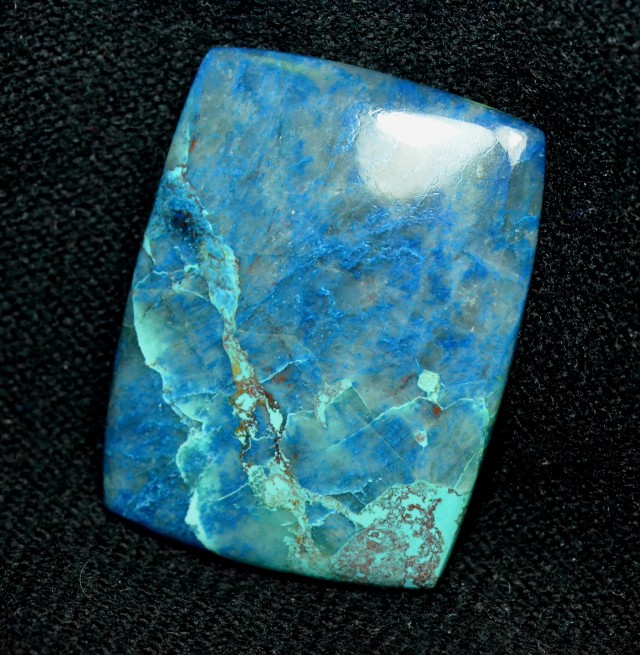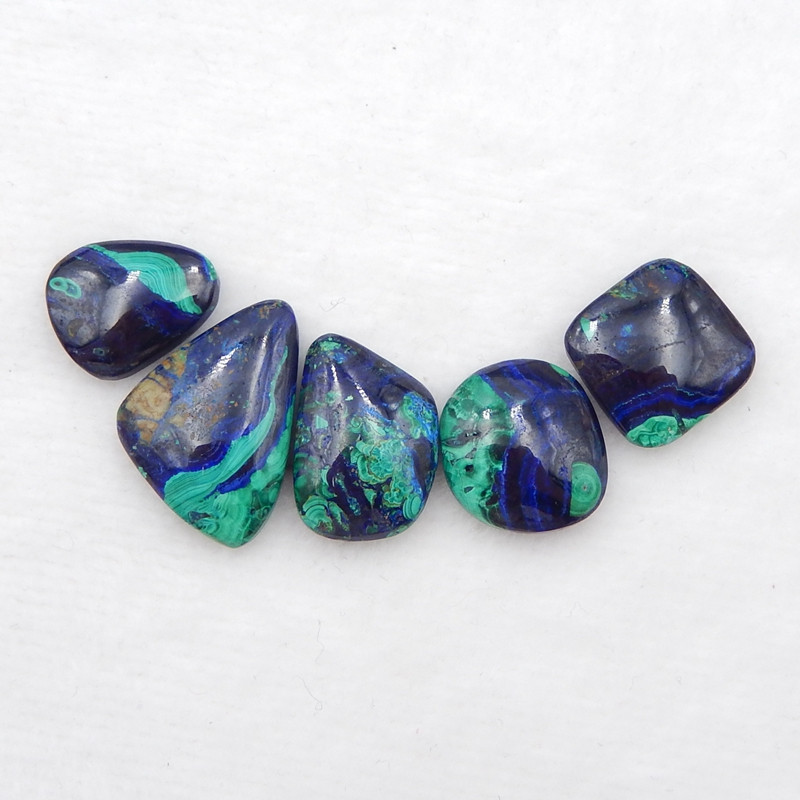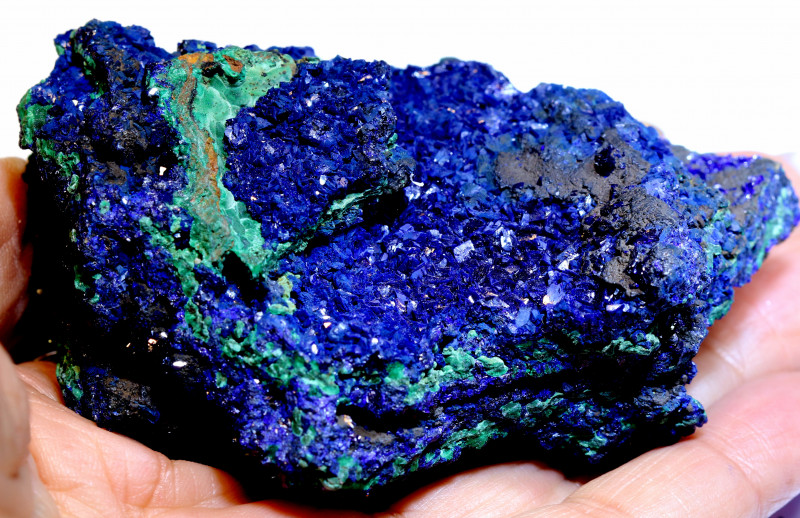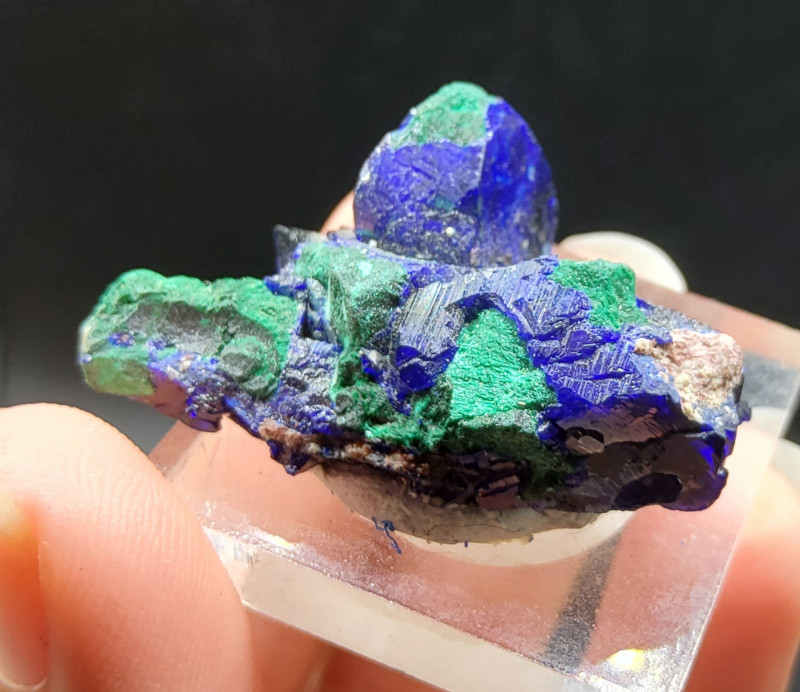
Azurite Gemstone: Nneɛma, Nkyerɛase, Botae & Nea Ɛkeka Ho
 Azurite yɛ kɔbere carbonate a ɛyɛ bruu a wonim no sɛ ɛwɔ kɔla a ɛyɛ hyew ne abakɔsɛm a ɛware wɔ adwinni mu. Ɔbo no kɔla a ɛyɛ fɛ a ɛyɛ cobalt no maa adwumfo twitwiw no yɛɛ no paint ne dye mfehaha pii, na wotumi hu kɔla no wɔ wiase adwinni ahorow a agye din sen biara no bi mu.
Azurite yɛ kɔbere carbonate a ɛyɛ bruu a wonim no sɛ ɛwɔ kɔla a ɛyɛ hyew ne abakɔsɛm a ɛware wɔ adwinni mu. Ɔbo no kɔla a ɛyɛ fɛ a ɛyɛ cobalt no maa adwumfo twitwiw no yɛɛ no paint ne dye mfehaha pii, na wotumi hu kɔla no wɔ wiase adwinni ahorow a agye din sen biara no bi mu.
Renaissance mfoniniyɛfo baanu a wɔagye din a wɔde azurite aduru dii dwuma ne Raphael ne Hans Holbein Kumaa.
Italiani mfoniniyɛfo Raphael afɔremuka ho mfonini Madonna and Child Enthroned with Saints no wɔ bruu a ɛyɛ azurite wɔ Madonna nkatanim mu, ɛwom sɛ wim tebea asɛe de malachite aduru a ɛyɛ ahabammono asi azurite bruu ananmu de.
Germanni mfoniniyɛfo Hans Holbein Kumaa de azurite aduru yɛɛ ne mfonini a ɛne Lady with a Squirrel and a Starling , a ɛbɛyɛ sɛ ɛyɛ Anne Lovell, Henry VIII esquire yere ho mfonini no akyi bruu no.
Nanso, nea Azurite kyerɛ no trɛw kɔ akyiri sen adwinni wiase no. Wɔ akwankyerɛ yi mu no, yɛbɛhyɛ wo ma wɔ biribiara a ɛsɛ sɛ wohu fa azurite ɔbo ho, efi sɛnea wubetumi de adi dwuma de asa yare so kosi nea ɛkɔ azurite bo mu.
Dɛn Ne Azurite?
Azurite yɛ tete aboɔden abo a ɛsom bo fã bi a ɛda wim bruu a ɛsakrasakra adi. Mpɛn pii no, azurite da wim bruu a ɛyɛ fɛ na emu dɔ adi bere a ade asa, te sɛ Van Gogh Starry Night .
Wɔde azurite zodiac ɔbo hyɛ wɔn a wɔwoo wɔn wɔ Sagittarius ase no anuonyam ! Sɛ azure aboɔden abo a ɛkyekyere awɔw bere mu blues yi da nkyɛn a, azurite abo metaphysical su ahorow hyɛ Sagittarius a ɔyɛ onyansafo nkuran sɛ wɔmfa wɔn ho nhyɛ wɔn nimdeɛ ho anigye mu.
Mpɛn pii no, azurite ne ne yɔnko kɔbere carbonate fra ma ɛyɛ azurite malachite a wɔaka abom. Ɔbo foforo a wɔfrɛ no azurmalachite no yɛ nea ɛfata ma yɛn nnamfo a wɔwɔ Aquarius no!
Sɛ azurmalachite a ɛte sɛ wiase nyinaa da nkyɛn a, azurite malachite agude a wɔhyɛ no betumi ama Aquarius nnipa mmoa su ahorow ada adi, na ahyɛ wɔn bo a wɔasi sɛ wɔbɛma wiase no ayɛ yiye no ho nkuran.
Aboɔden abo Su ahorow
Azurite ɔbo yɛ kɔbere carbonate a ɛwɔ asase so titiriw biako pɛ, na malachite nkutoo na ɛka bom . Azurite ntumi nnyina yiye te sɛ malachite, na wim tebea taa dan azurite ma ɛbɛyɛ malachite.
Azurite betumi ayɛ sɛ druzy , ahwehwɛ a enyin a ahwehwɛ nketenkete pii a ɛhyerɛn a ɛhyerɛn te sɛ asikre wom. Azurite betumi anyin wɔ ahwehwɛ afoforo mu, titiriw malachite ne chrysocolla .
Chrysocolla ahorow biako a ɛda nsow a azurite wom ne Parrot Wing, aboɔden abo a wɔde azurite, jasper, ne quartz afra . Israel Eilat ɔbo a agye din no de chrysocolla fra azurite, malachite, ne turquoise.
On the Mohs mineral hardness scale , azurite minerals rank at a low 3.5 to 4. Sɛ wopɛ azurite nyansahu mu nsɛm a aka no a, hwɛ nea wɔahyehyɛ wɔ ase ha no!

Azurite Nkyerɛkyerɛmu & Su ahorow
Kɔla: Azure bruu a ɛwɔ ahorow ahorow
Ahwehwɛ nhyehyɛe: Monoclinic
Luster: Vitreous (te sɛ ahwehwɛ) kosi sɛ ɛyɛ dull
Nneɛma a ɛda adi pefee: Mpɛn pii no, ɛnyɛ nea ɛda adi pefee; Ɛntaa mma sɛ ɛyɛ translucent kosi transparent
Nneɛma a ɛma hann yɛ hyew: 1.72-1.84
Nneɛma a ɛyɛ den: 3.7-3.9
Cleavage: Ɛyɛ pɛpɛɛpɛ wɔ [011] so; Fair wɔ [100] so; Ahiafo wɔ [110] so.
Akisikuru: Conchoidal
Streak: Bruu a ɛyɛ hann
Pleochroism: Ɛwɔ hɔ mprempren na ɛyɛ den; Blue shades a ɛyɛ fɛ
Sɛ yefi mineralogy mu a, dɛn na ɛsɛ sɛ yehu fa azurite crystal ntease ho?
Azurite Ɔbo Nkyerɛase
Azurite aboɔden abo wɔ din kakraa bi, a lapis armenus, azurium citramarinum, ne ne din a edi kan: lajevard ka ho. Asɛmfua lajevard yɛ tete Persia asɛmfua a wɔde gyina hɔ ma beae bi a ɛwɔ Arabia Po no so a wonim no sɛ ɛwɔ aboɔden abo a ɛyɛ bruu a ɛyɛ bruu.
Woate lapis lazuli ho asɛm pɛn ? Mfiase no wɔde Lajevard mpɔtam hɔ din too Azurite ne lapis lazuli nyinaa. Latin asɛmfua a na wonim no wɔ Arabic kasa mu sɛ lazaward , na awiei koraa no ebegyee ne ho sɛ lapis lazuli , anaa “ɔbo bruu a ɛyɛ kurukuruwa.”
Wɔ nnɛyi honhom mu akuw mu no, azurite yɛ nyansa, ayaresa, ne nkate ho sɛnkyerɛnne.
Tete aman de azurite bataa ɔsoro ahintasɛm ahorow a wɔda no adi ho. Azurite abodin “Ɔsoro Ɔbo” no fi tete Chinafo gyidi ahorow a ɛne sɛ egyina hɔ ma ɔpon bi a ɛda ɔsoro ne asase ntam no mu.
Abibifo te sɛ Mayafo ne Amerikafo Ankasa de azurite ntease kyekyeree adwene mu tumi ahorow ho. Mayafo huu azurite sɛ adwinnade a wɔde nya nyansa fi honhom fam, bere a Amerikafo Ankasa de ɔbo no dii dwuma de ne ahonhom akwankyerɛfo di nkitaho.
Wɔ Helafo anansesɛm mu no, azurite ne Athena, ɔko ne nyansa nyamewa no wɔ abusuabɔ. Misrifo anansesɛm ahorow de azurite bata Isis, nkwa nyamewa a na ɔyɛ ayaresa ne nhumu ho sɛnkyerɛnne wɔ tumi afoforo mu no ho.
Ná Misrifo nso gye di sɛ azurite ne wim nyame kumaa Horus wɔ abusuabɔ na ɛtɔ mmere bi a na wɔde azurite paint bedi dwuma de Horus aniwa ahyɛ wɔn moma so de abɔ wɔn ho ban.
Yenim tete de a wɔde di dwuma, nanso nnɛ, dɛn na wɔde azurite di dwuma?

Azurite Ayaresa Nneɛma
Ɛlektrik wosow a ɛwɔ aboɔden abo biara mu no ma ɛyɛ ahwehwɛ a mfaso wɔ so a ɛsa yare . Azurite ayaresa su ahorow di akɔneaba wɔ akwan a wɔasiw a wɔpopa ne nimdeɛ a ɛkɔ so no a wɔma ɛkɔ so no ho.
Te sɛ aboɔden abo afoforo a ɛyɛ bruu , azurite bruu fi awosu mu wɔ su ahorow a ɛma wɔde wɔn adwene si biribi so, ahotoso, ne nkate mu yɛ kɛse.
Ayaresa pɔtee bɛn na wubetumi de azurite aboɔden abo ayɛ?
Nipadua mu Ayaresa
Azurite ayaresa tumi de n’ani si nipadua no atifi, na ɛtew ɛyaw a ɛwɔ menewa, mmati, ne kɔn mu no so. Wɔkyerɛ sɛ ɔbo no ma mogya no kɔ nipadua no mu yiye na ɛtew vertigo so.
Wɔtaa de azurite di dwuma de yɛ nea ɛne ne ho hyia, titiriw de yɛ akyi berɛmo anaa nkwaa a ɛne ne ho hyia. Wobetumi de tumi a ɔbo no tumi yi akwan mu no adi dwuma de ama ntini akwan a ɛkɔ amemene no mu no akɔ soro na ama onyin nkɛntɛnso a ɛwɔ adwene mu ahokeka so no ayɛ brɛoo.
Nkate mu Ayaresa
Sɛ wopere sɛ wobɛte nka sɛ woba fam, wunni ahobammɔ, anaasɛ womfata a, azurite wɔ ha sɛ ɛbɛboa. Wɔ nkate fam no, azurite metaphysical properties betumi asɛe ankasa ho asɛm a enye ne obu a ɛba fam wɔ ne ho no.
Wɔ nhyɛso a ɛwɔ abusuabɔ mu, sɛ́ ɛyɛ abusua, ɔdɔ, anaa adamfofa su ho no, azurite betumi ama emu ada hɔ wɔ nea asɛm no ntini yɛ ho. Sɛ wodi fibea no ho dwuma wie a, azurite betumi ahyɛ nkɔmmɔbɔ a ɛda adi pefee, a ɛyɛ nokware ho nkuran sɛnea ɛbɛyɛ a wo ne wo dɔfo no betumi akɔ ayaresa so.
Chakra Ayaresa
Pii kɔ chakra ayaresa mu? Wubetumi azurite ama aniwa chakra a ɛto so abiɛsa no kari pɛ! Aniwa anaa anim chakra a ɛtɔ so mmiɛnsa no nyinaa fa nteaseɛ a ɛkorɔn ho, baabi a yɛde gye ne nimdeɛ hwɛ wiase ne yɛn ho.
Sɛ aniwa a ɛto so abiɛsa no nkari pɛ a, ebia yɛbɛte nka sɛ yɛn nneyɛe bɔne no adi yɛn so, na yɛakɔhyɛ tebea a yɛmfa nyɛ hwee mu. Sɛ yɛkura anaa yɛhyɛ azurite agude wɔ baabi a ɛbɛn chakra no, te sɛ azurite asomuade a, ebetumi akari pɛ wɔ aniwa a ɛto so abiɛsa no mu na ama yɛatumi ayɛ nneɛma a yɛn ani gye ho a yɛnte nka sɛ wɔasiw yɛn kwan.
Woasiesie wo ho sɛ wubefi ase de azurite asa yare? Ansa na wobɛtɔ bi no, kenkan yɛn adetɔ ho afotu a ɛwɔ ase ha no na ama woahwɛ ahu sɛ wubenya azurite a ɛyɛ papa.

Azurite Aboɔden Aboɔ Nneɛma a Ɛwɔ Hɔ
Aboɔden abo ho ɔbenfo anaa nea ɔboaboa ano biara nim sɛ ɔbo biara bo gyina ne su so, su horow a abenfo de kyerɛ sɛnea ɛyɛ papa.
Sɛ woretɔ azurite a, su horow a ɛsɛ sɛ wode sie w’adwenem ne kɔla, nea wɔatwitwa, carat mu duru, ne ayaresa ahorow.
Ahosuo
Azurite kɔla yɛ bruu bere nyinaa, ɛwom sɛ ebia ɛbɛyɛ te sɛ nea ɛyɛ mmerɛw, ɛyɛ hyew, anaasɛ ɛyɛ tuntum de. Azurite ahwehwɛ akɛse taa yɛ bruu a emu dɔ, bere a ahwehwɛ nketewa betumi ayɛ mmerɛw esiane wim tebea nti.
Sɛ malachite fra mu a, malachite ma nsensanee a ɛyɛ ahabammono a ɛhyerɛn ma azurite akyi bruu no. Ebia wɔde nhama abɔ ɔbo a wɔaka abom a wɔfrɛ no azurmalachite no nso. Nea ɛyɛ serew no, kɔbere na ɛma azurite yɛ bruu ne malachite yɛ ahabammono.
Twa
Azurite a ɛyɛ den, mpaapaemu a edi mũ, ne ɔhyew a ɛyɛ mmerɛw no ma ɔbo no a wobetwa no yɛ anifere. Azurite a ɛwɔ afã horow no ho yɛ na na wɔde ahwehwɛ nketenkete nkutoo na ɛyɛ. Nea ɛbɛyɛ na amma abubu no, faceted azurite taa kɔ agude a ahobammɔ wom sɛ wɔbɛbɔ, te sɛ asomuade ne pendants so.
Wɔtaa twitwa azurmachite sen azurite nkutoo, efisɛ malachite ma ɔbo no tumi kyɛ. Nanso, azurmalachite agude ntaa mma te sɛ azurmalachite cabochons anaa nwene.

Carat Mu duru
Wɔtaa hu Azurite rough sɛ nhwɛsode akɛse anaa nodular, na ahwehwɛ a ɛte sɛ aboɔden abo ho yɛ na. Azurite crystal biara a ɛwɔ facetable no bɛtaa ayɛ nea ne tenten nnu 2cm.
Azurite nhwɛsode akɛse taa kɔla yɛ tuntum. Mpɛn pii no, agudeyɛfo de saa nhwɛsode akɛse yi yɛ azurite cabochons. Nanso, mpɛn pii no, azurite akɛse yɛ azurite ne malachite a wɔde afra, a lapidaries pii di adwini yɛ no nhwiren anaa nneɛma a wɔde siesie fie de kyerɛ ɔbo no kɔla ahorow a ɛyɛ nwonwa.
Ayaresa & Nneɛma a Wɔde Yɛ Nneɛma
Wɔntaa mfa nnuru a wɔde yɛ nneɛma anaa ɔhyew nyɛ Azurite ho adwuma, nanso wɔtaa de nneɛma a wɔde kata so ne nea wɔde hyɛ mu ma. Mpɛn pii no, wɔde nneɛma a wɔde hyɛ mu di dwuma na ama ɔbo no agyina yiye. Nea ɛbɛyɛ na azurite no ayɛ hyew no, ebia ɔbo no benya wax anaa resin a wɔde akata so.
Azurite a wɔayɛ no yɛ nea asase ho animdefo ani gye ho sɛ nyansahu mu nhwɛsode na mfoniniyɛfo ani gye ho sɛ aduru a wɔde yɛ kɔla a ɛho ka sua. Wɔ aboɔden abo fam no, azurmalachite a wɔayɛ anaa wɔasan ayɛ no yɛ nea nkurɔfo ani gye ho kɛse, a wɔde plastic a wɔde azurmalachite a wɔahyɛ no den a wɔde bɛhyɛ agude anaa cabochons mu na ɛyɛ.
Akwan a wɔfa so yɛ azurite wɔ aduruyɛ mu fii ase mfehaha pii a atwam ni na edii dwuma titiriw wɔ azurite abakɔsɛm mu.

Azurite Abakɔsɛm
Azurite a wɔde di dwuma no fi tete Misraim, faako a nkurɔfo de azurite powder yɛɛ “Misraim bruu” aduru no. Tete Helani abɔde ho nimdefo a wagye din Pliny Ɔpanyin no kyerɛw azurite ho asɛm, na ɔde Hela kasa kuanos anaa Latin caeruleum , a ne nyinaa kyerɛ “blue a emu dɔ” dii dwuma.
Asia Apuei fam wɔ azurite mfonini ahorow nso mu kyɛfa a ɛfata, a tete abodan mu mfonini ahorow a ɛwɔ China Atɔe fam ne afeha a ɛto so 15 kosi 18 mu ɔfasu ho mfonini ahorow pii a ɛwɔ Tibet ahemfie ne nkokorafie ahorow mu ka ho.
Efi Mfinimfini Mmere no mu kosi Asetra Foforo no mu no, na azurite yɛ Europa fibea titiriw a ɛma wonya nneɛma a wɔde yɛ bruu. Europa azurite dodow no ara fi France.
France de azurite a wɔde asie a ɛho hia a edi kan no mu biako hoahoa ne ho, na ɛwɔ Chessy. Nneɛma a wɔde asie no ma wonyaa azurite Fransefo aguadi din chessylite.
Wɔ afeha a ɛto so 18 mu no, aduru a nnipa ayɛ a wɔde yɛ kɔla bruu besii abɔde mu azurite ananmu, efisɛ na aduru foforo no yɛ nea ɛkɔ so daa, ɛho ka sua, na ɛnyɛ den sɛ wɔde bɛyɛ adwuma.
Bere a azurite nni abakɔsɛm a ɛware sɛ aboɔden abo no, agudeyɛfo binom de ɔbo no kɔla a ɛyɛ nwonwa no adi dwuma.
Onipa a ɔte saa no mu biako ne David Webb, Amerikani agudeyɛfo bi a wagye din a wonim no sɛ ɔyɛ nneɛma asinasin ma wɔn a wɔagye din te sɛ Elizabeth Taylor ne Barbra Streisand.
Webb de azurite ne azurmalachite kaa azurite nkaa a wɔasen anaasɛ wɔde daimond ayɛ mu. Webb asinasin no bi da so ara wɔ aguadidan mu, te sɛ azurite malachite mpɛtea fɛfɛ bi a efi 1970 mfe no mu.
Ansa na wɔbɛyɛ no asinasin a ɛyɛ fɛ no, ɔkwan bɛn so na wɔyɛ azurite?

Azurite Abo Mfiase & Fibea
Azurite nyin wɔ kɔbere a wɔde asie mu sɛ aboɔden abo a ɛto so abien. Aboɔden abo a ɛtɔ so mmienu yɛ aboɔden abo a adan afiri aboɔden aboɔ baako (aboɔden aboɔ titire) akɔ aboɔden aboɔ foforɔ mu ɛnam wim tebea nti.
Azurite aboɔden abo a ɛba no nam nkitahodi a ɛda nsu a carbon dioxide pii wom ne kɔbere a wɔde yɛ nneɛma ntam so na ɛba. Nnuru a wɔde yɛ aduru no ma kɔbere a wɔde yɛ nneɛma no tew nkakrankakra bere a nsu no reyɛ ayɛ hyew nkakrankakra, na ɛma yenya azurite.
Mpɛn pii no, wɔn a wotu fam no hwehwɛ azurite ne/anaasɛ malachite de hu sɛ ebia kɔbere pii wɔ baabi a wɔde asie anaa.
Ebia na malachite a ɛwɔ azurite a wotu mu no amfi ase sɛ malachite. Azurite yɛ malachite atoro, a ɛkyerɛ sɛ ɛtɔ mmere bi a azurite dan malachite. Sɛ nsakrae yi ba a, wim tebea ma nsu mu nneɛma nketenkete si carbon dioxide molecule ananmu, na ɛma wonya ɔbo foforo no.
Sɛ ɛba wie a, ɛhe na wohu azurite?
Mmeae a Wɔtu Tuo
Ɛnnɛ, azurite a ɛda nsow sen biara wɔ U.S., France, ne Australia. U.S. atopae a ɛsow aba sen biara wɔ Arizona, Utah, ne New Mexico.
Ɛhe bio na wubetumi anya azurite?
China
Congo
England
Germany
Greece na ɛwɔ hɔ
Italy
Mexico
Morocco na ɛwɔ hɔ
Namibia na ɛwɔ hɔ
Pakistan
Peru
Russia
Slovakia na ɛwɔ hɔ
Afei, momma yɛnka bo ho asɛm. Azurite bo yɛ ahe?

Azurite Bo & Ne Bo
Ɛmfa ho mmeae pii a wubetumi ahu azurite no, mineral no nkutoo nnɔɔso. Ma eyi ntra w’adwenem bere a worehwɛ sɛnea azurite bo yɛ den no.
Esiane sɛ azurite kronkron ne nea ɛho yɛ na sen biara nti, ɛho ka yɛ den sen biara. Azurite kronkron nketenkete, sɛ́ ɛyɛ nea wɔannoa anaasɛ wɔahwe ase no, taa yɛ dɔla 20 kosi 50 anyɛ yiye koraa no. Azurite a ɛyɛ den mpo, sɛ ɛho tew a, ebetumi abɔ bɛboro dɔla 10,000.
Ɛda adi sɛ wubehu sɛ wɔde malachite afrafra azurite mineral bi mu, na ɛma azurite bo so tew kɛse.
Rough azurmalachite taa yɛ $0.40-$1 wɔ carat biara mu wɔ bo a wɔtɔn no kɛse mu. Mpɛn pii no, malachite ne azurite cabochon bo bɛyɛ dɔla biako wɔ carat biara ho.
Azurite Hwɛ ne Nsiesiei
Sɛ wopɛ sɛ wohohoro azurite ho a, yɛhyɛ nyansa sɛ fa ntama a ɛyɛ mmerɛw popa nea ɛwɔ soro no brɛoo. Wubetumi de nsu a ɛyɛ nwini adi dwuma nanso ma azurite ntwe ne ho mfi nneɛma a wɔde tew nneɛma ho a acid wom ho.
Te sɛ afieboa a wɔdɔ no no, awerɛhosɛm ne sɛ azurite nyin ntɛmntɛm sen yɛn. Kɔla no betumi ayera wɔ hann a ano yɛ den ne mframa a ɛda hɔ mpo ase. Wɔ ɔhyew no ase no, azurite bɛhwere ne kɔla ne ne nhyehyɛe koraa, na adan powder tuntum.
Hwɛ hu sɛ wubeyi azurite agude bere a wode wo ho hyɛ apɔw-mu-teɛteɛ mu anaasɛ sɛ wobɛkɔ owia hann tẽẽ mu a. Sɛnea ɛbɛyɛ a ahobammɔ bɛba no, nyɛ azurite nhwɛsode ahorow a wunhia ahobammɔ da, efisɛ kɔbere mfutuma a wobɛhome no yɛ asiane.
Te Ɔsoro nka wɔ Azurite ho!
Ɛno yɛ wrap wɔ azurite so! Esiane sɛ azurite yɛ fɛ na ɛsa yareɛ nti, ɛnyɛ nwonwa sɛ wɔfrɛ azurite “Ɔsoro Ɔboɔ.”
Obiara a okura azurite aboɔden abo anaasɛ ɔhyɛ azurite abɔso no, akyinnye biara nni ho sɛ ɔbɛte ɔbo no ɔsoro wosow no nka!
搜尋Gemstone Encyclopedia
相關拍賣
相關文章
Momma yɛnkyerɛkyerɛ sɛnea wɔtɔ aboɔden abo wɔ intanɛt so. Yɛwɔ aboɔden aboɔ a ɛso sen biara wɔ intanɛt so na ɛbɛtumi ayɛ den kakra wɔ mfitiaseɛ no. Ma yɛmfa afotu bi a mfaso wɔ so mmoa wo.
3rd Oct 2018
W’aboɔden abo a wobɛhwɛ so no boa ma ɛyɛ fɛ wɔ wo nkwa nna nyinaa mu. Yɛbɛka nneɛma te sɛ denden ne ayaresa ho asɛm, ne anammɔn a ɛfa sɛnea wobɛhohoro wo aboɔden abo na wode asie dwoodwoo ho.
9th May 2018
So woasusuw sɛnea wɔyɛ Ruby aboɔden abo ho pɛn? Ayaresa ahorow pii wɔ gua so na yɛbɛboa ma yɛakyerɛkyerɛ mu
9th May 2018
最新的文章
Nnua a wɔde asonse a wɔasen a wɔsan frɛ no nhabannuru asonse no yɛ abɔde mu ade a wɔde si asono asonse ananmu, na wotwa fi Amerika Kesee Fam phytelephas nnuadewa mu nnuadewa mu wɔ abrabɔ pa mu. Sua mmɛw asonse ho ade nyinaa wɔ akwankyerɛ yi mu!
15th Jan 2026
Chrysanthemum nhwiren abo yɛ abɔde mu anwonwade a ɛwɔ calcite, celestite, anaa andalusite nhwiren fitaa bi a wɔde asisi limestone tuntum anaa atɛkyɛ abo so.
13th Jan 2026
Rainbow lattice sunstone yɛ feldspar ahorow a ɛwɔ optical nsunsuanso abiɛsa fɛfɛ a efi nneɛma ahorow a wɔde ka ho a ɛwɔ hɔ no mu ba. Ɛyɛ ogya kɔla display ne lattice nsusuwso ma ɛyɛ coletor abohene a wɔntaa nhu!
12th Jan 2026
文章類別
How To's is where you will find helpful articles from gem Rock Auctions on how to cut gemstones, select gemstones and buy gemstones.
9文章





